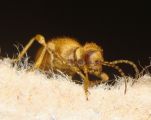
Русские, остановите эту войну! Спасите Свободную Украину!
Russians, stop this war! Save Free Ukraine!
Biodiversity Map
Taxa

Niptus — subordinate taxa:
Taxon count: 1
-
Arthropodaphylum
Click to switch
to select orders
and filters > -
Hexapodasubphylum
Click to switch
to select orders
and filters > -
Insectaclass
Click to switch
to select orders
and filters > -
Coleopteraorder
Click to set
as the main taxon
and as a base
← of the left panel > -
Polyphagasuborder
Click to set
as the main taxon
and as a base
← of the left panel > -
Bostrichiformiaseries
Click to set
as the main taxon
and as a base
← of the left panel > -
Bostrichoideasuperfamily
Click to set
as the main taxon
and as a base
← of the left panel > -
Ptinidaefamily
Click to set
as the main taxon
and as a base
← of the left panel > -
Ptininaesubfamily
Click to set
as the main taxon
and as a base
← of the left panel > -
Ptininitribe
Click to set
as the main taxon
and as a base
← of the left panel > -
Niptusgenus
Click to set
as the main taxon
and as a base
← of the left panel >
PL
YES
name status: valid name
BioMap ID: 1016673
taxon code: 3084
taxonomy checked: YES
source of names: Löbl et Smetana 2007
Data on distribution in Poland

Statistics
- Records: 73
- Publications: 43
- Collections: 5
- Publication authors: 39
- Illustrations (iconography): 1
- Photos (specimen/observation): 1
Taxon description
Gatunek, pochodzący ze wschodniej części Azji, został zawleczony do Ameryki Północnej i Południowej oraz do Europy, gdzie zadomowił się w osiedlach ludzkich, docierając do najdalszych północnych krańców kontynentu. W Polsce był rzadko i sporadycznie znajdowany i jest znany przeważnie z pojedynczych stanowisk w poszczególnych krainach. Larwy żerują w suchych produktach żywnościowych pochodzenia roślinnego, na przykład w mące, płatkach owsianych, ryżu, chlebie i odpadkach zbożowych; były notowane również jako szkodniki materiałów tekstylnych, zwłaszcza zawierających wełnę. Rozwój larwalny przebiega zwykle w ciągu około 130 dni i dlatego mogą niekiedy występować dwa pokolenia rocznie. Przepoczwarczenie w materiałach sypkich następuje w kokonie, uprzednio sporządzonym przez larwę, natomiast w komorach poczwarkowych wywierconych w drewnie brak jest kokonu.
Illustrations
... browse
 Niptus
Niptushololeucus
Photos
... browse
 Niptus
Niptushololeucus
External data sources
- Ostatnie rekordy
-
1057393
 ×
× Ptinidae: Niptus hololeucus, PL, ad Kluczbork, 1988, leg. R. Królik
Ptinidae: Niptus hololeucus, PL, ad Kluczbork, 1988, leg. R. Królik -
1053794
 ⊡
⊡ Ptinidae: Niptus hololeucus, PL, Wyżyna Krakowsko-Wieluńska, Olsztyn, UTM CB72, 2006, leg. B. Bujnik
Ptinidae: Niptus hololeucus, PL, Wyżyna Krakowsko-Wieluńska, Olsztyn, UTM CB72, 2006, leg. B. Bujnik -
1053793
 ⊡
⊡ Ptinidae: Niptus hololeucus, PL, Wyżyna Krakowsko-Wieluńska, Olsztyn, UTM CB72, 2006, leg. B. Bujnik
Ptinidae: Niptus hololeucus, PL, Wyżyna Krakowsko-Wieluńska, Olsztyn, UTM CB72, 2006, leg. B. Bujnik -
1053792
 ⊡
⊡ Ptinidae: Niptus hololeucus, PL, Wyżyna Krakowsko-Wieluńska, Olsztyn, UTM CB72, 2006, leg. B. Bujnik
Ptinidae: Niptus hololeucus, PL, Wyżyna Krakowsko-Wieluńska, Olsztyn, UTM CB72, 2006, leg. B. Bujnik -
1053791
 ⊡
⊡ Ptinidae: Niptus hololeucus, PL, Wyżyna Krakowsko-Wieluńska, Olsztyn, UTM CB72, 2006, leg. B. Bujnik
Ptinidae: Niptus hololeucus, PL, Wyżyna Krakowsko-Wieluńska, Olsztyn, UTM CB72, 2006, leg. B. Bujnik -
1034805
 ⊡
⊡ Ptinidae: Niptus hololeucus, PL, Pojezierze Mazurskie, warmińsko-mazurskie, Mrągowo, Piecki, UTM EE14, 2011
Ptinidae: Niptus hololeucus, PL, Pojezierze Mazurskie, warmińsko-mazurskie, Mrągowo, Piecki, UTM EE14, 2011 -
772237
 ⊡
⊡ Ptinidae: Niptus hololeucus, PL, Sudety Zachodnie, Karkonosze, Karpacz, UTM WS52, 1990, leg. A. Malkiewicz, coll. Uniw. Wrocławski, ZBiTE
Ptinidae: Niptus hololeucus, PL, Sudety Zachodnie, Karkonosze, Karpacz, UTM WS52, 1990, leg. A. Malkiewicz, coll. Uniw. Wrocławski, ZBiTE -
771024
 ×
× Ptinidae: Niptus hololeucus, PL, Karkonosze, Szklarska Poręba Śr., 1995, leg. L. Borowiec, coll. Uniw. Wrocławski, ZBiTE
Ptinidae: Niptus hololeucus, PL, Karkonosze, Szklarska Poręba Śr., 1995, leg. L. Borowiec, coll. Uniw. Wrocławski, ZBiTE -
770545
 ×
× Ptinidae: Niptus hololeucus, PL, Wrocław, 1978, leg. L. Borowiec, coll. Uniw. Wrocławski, ZBiTE
Ptinidae: Niptus hololeucus, PL, Wrocław, 1978, leg. L. Borowiec, coll. Uniw. Wrocławski, ZBiTE -
770134
 ⊡
⊡ Ptinidae: Niptus hololeucus, PL, Sudety Zachodnie, Zieleniec, UTM WR97, 1975, leg. L. Borowiec, coll. Uniw. Wrocławski, ZBiTE
Ptinidae: Niptus hololeucus, PL, Sudety Zachodnie, Zieleniec, UTM WR97, 1975, leg. L. Borowiec, coll. Uniw. Wrocławski, ZBiTE - ... more
- Powiązane publikacje
-
Borowski J. 1993b. Nowe stanowiska i uwagi o niektórych polskich kołatkowatych (Coleoptera, Anobiidae). Wiad. Entomol., 12(1):55 [59].
 full text
full text Show records
Show records -
Burakowski B., Mroczkowski M., Stefańska J. 1986c. Chrząszcze – Coleoptera. Dermestoidea, Bostrichoidea, Cleroidea i Lymexyloidea. Katalog Fauny Polski, XXIII, 11, Warszawa.
 Show records
Show records -
Kamiński E. 1972. Choroby, szkodniki i chwasty zarejestrowane na towarach pochodzenia roślinnego przy wwożeniu ich do Polski w latach 1967-1969. Biul. IOR, 53:33-93.
 Show records
Show records -
Górny M. 1968b. Faunal and zoocenological analysis of the soil insect communities in the ecosystem of shelterbelt and field. Ekol. Pol., A, 16:297-324.
 Show records
Show records -
Pawłowski J.S. 1967a. Chrząszcze (Coleoptera) Babiej Góry. Acta Zool. Cracov., 12:419-665.
 Show records
Show records - ... more






